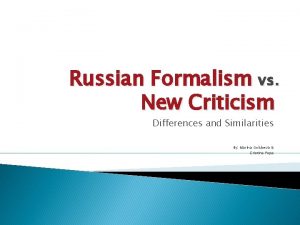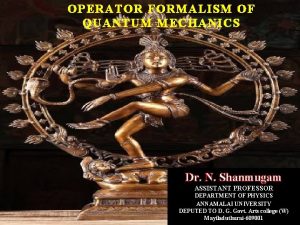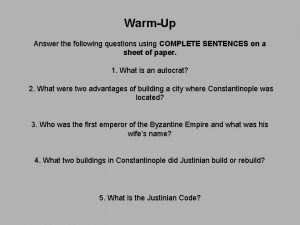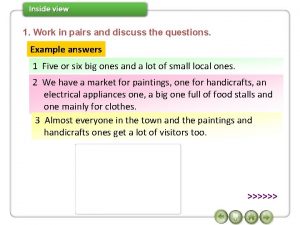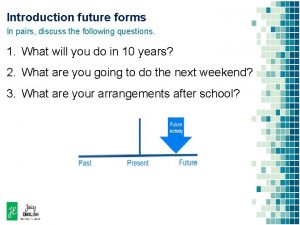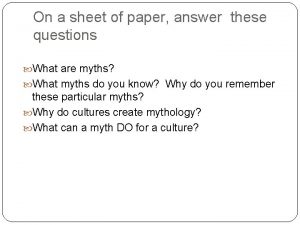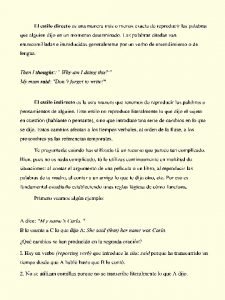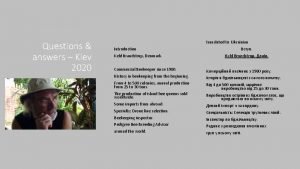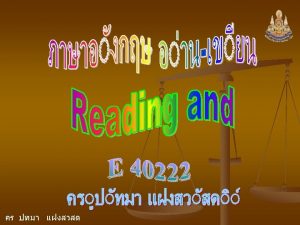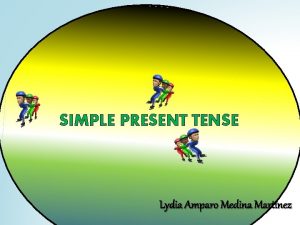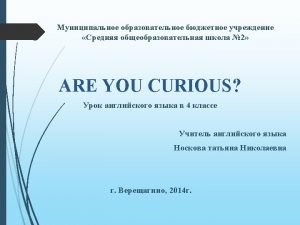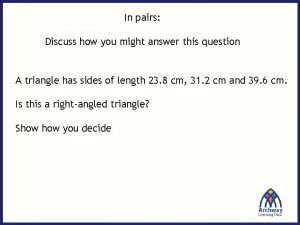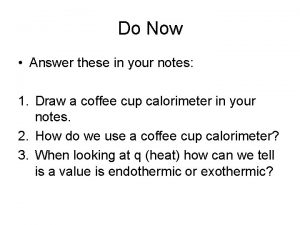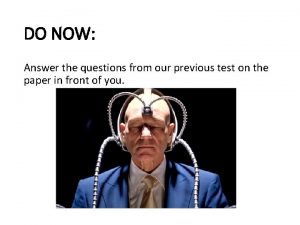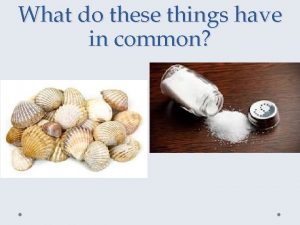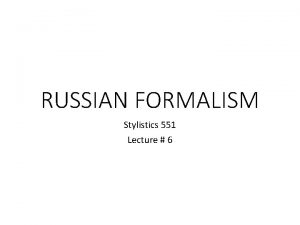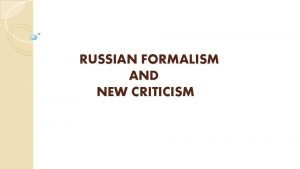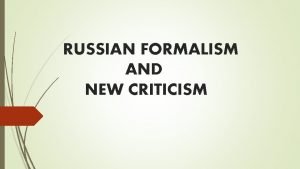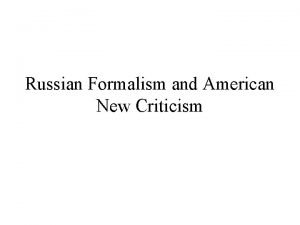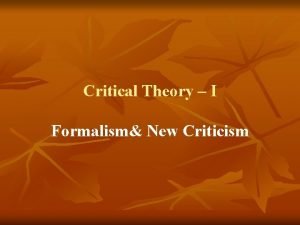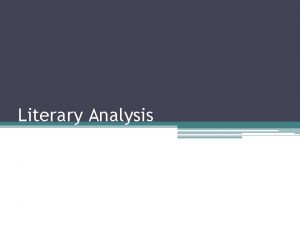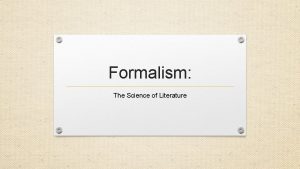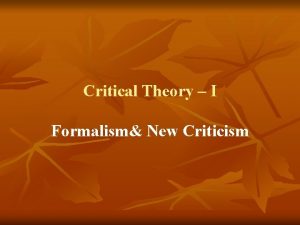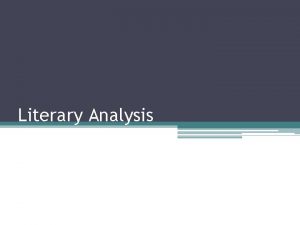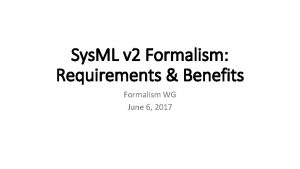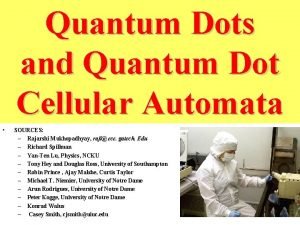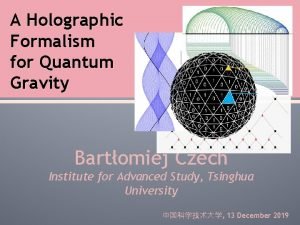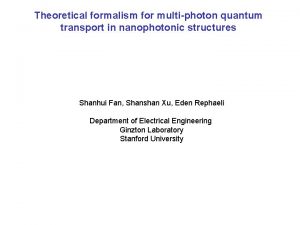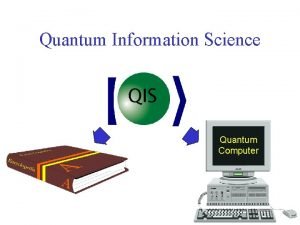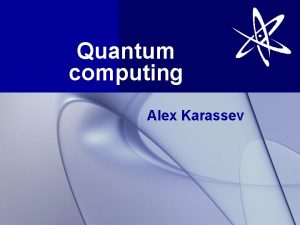Quantum Automata Formalism These are general questions related





































- Slides: 37

Quantum Automata Formalism

These are general questions related to complexity of quantum algorithms, combinational and sequential

Models of quantum sequential circuits 1. 2. 3. 4. 5. Quantum automata Quantum state machines Quantum Turing Machines Quantum Robots of Benioff Quantum Cellular Automata (not quantum dot based).

A new formalism for classical (deterministic) automata

Input state 1 Input state 2 Output state 1 Output state 2 Observe that this matrix is not permutative and not unitary This means that external classical computer has to change the quantum circuit when a new input in the string comes


A formalism for classical non-deterministic automata

Nondeterminism for b Observe that this matrix is not permutative and not unitary

There are two paths from state 1 to state 2, which have labels sequence bb Using matrices like these we can analyze if certain transitions in graphs exist and how many of them exist. This is used in finding the languages accepted be the automata

A FORMALISM FOR CLASSICAL PROBABILISTIC AUTOMATA

PROBABILISTIC AUTOMATA

Languages accepted by probabilistic automata

A FORMALISM FOR QUANTUM AUTOMATA

Quantum Finite Automata = QFA Now unitary matrices

Probability that an automaton accepts a string bra Unitary matrix ket

Languages accepted by deterministic automata • Review the following: 1. the concept of Rabin-Scott automaton and language accepted by it. 2. Review the concept of regular expression 3. Show a link between regular expression and language accepted by an automaton. 4. Language generated by an automaton. 5. Regular languages

Languages accepted by probabilistic automata Unitary matrices used here are only a subset of all matrices

Model of Quantum Automaton • • Quantum automaton is programmed from deterministic standard automaton. It is more similar to FPGA than normal model of computing like in a processor. Finite memory 1. Machine here has a program that generates pulses that program QA. 2. This is like a memory in FPGA that stores information about LUT and connections CLASSICAL AUTOMATON One pulse for one elementary rotation in one qubit Infinite memory Quantum Automaton

Quantum Automaton described by a unitary matrix

CLASSICAL TURING MACHINES

Classical Turing Machines

Model of calculation of a standard Turing Machine polynomial

Example of Turing Machine The source of infiniteness is the tape head Automaton control the head Finite State Machine This machine has a finite memory, this is standard automaton. 1. 2. 3. 4. 5. Move left, move right, stop, write a symbol. Is the symbol in current cell Xi?

Non-Polynomial, Non-Polynomial these are tough problems in real life


Bounded-error probabilistic polynomial (BPP) • In computational complexity theory, bounded-error probabilistic polynomial time (BPP) is the class of decision problems that are: 1. solvable by a probabilistic Turing machine 2. in polynomial time, 3. with an error probability of at most 1/3 for all instances.

Bounded-error probabilistic polynomial • Informally, a problem is in BPP if there is an algorithm for it that has the following properties: 1. It is allowed to flip coins and make random decisions 2. It is guaranteed to run in polynomial time 3. On any given run of the algorithm, it has a probability of at most 1/3 of giving the wrong answer, whether the answer is YES or NO. BPP = Bounded-error Probabilistic Polynomial A complexity class

Bounded-error probabilistic polynomial


QUANTUM TURING MACHINES

A sum of two complex numbers can be a zero

BQP 1. In computational complexity theory BQP (bounded error quantum polynomial time) time is the class of decision problems solvable by a quantum computer in polynomial time, with an error probability of at most 1/3 for all instances. 2. It is the quantum analogue of the complexity class BPP. 3. In other words, there is an algorithm for a quantum computer (a quantum algorithm) that solves the decision problem with high probability and is guaranteed to run in polynomial time. 4. On any given run of the algorithm, it has a probability of at most 1/3 that it will give the wrong answer.

BQP (cont) 1. Similarly to other "bounded error" probabilistic classes the choice of 1/3 in the definition is arbitrary. 2. We can run the algorithm a constant number of times and take a majority vote to achieve any desired probability of correctness less than 1, using the Chernoff bound. 3. Detailed analysis shows that the complexity class is – unchanged by allowing error as high as 1/2 − n−c on the one hand, – or requiring error as small as 2−nc on the other hand, • where c is any positive constant, • and n is the length of input.



Sources:

• Used in 2011.
 Mikael ferm
Mikael ferm New criticism vs structuralism
New criticism vs structuralism Operators in quantum mechanics
Operators in quantum mechanics Quantum physics vs mechanics
Quantum physics vs mechanics Quantum physics vs quantum mechanics
Quantum physics vs quantum mechanics 2 types of fitness
2 types of fitness Fitness related images
Fitness related images This area along the german/belgian border was demilitarized
This area along the german/belgian border was demilitarized Diferencia entre gran plano general y plano general
Diferencia entre gran plano general y plano general Where did general lee surrender to general grant?
Where did general lee surrender to general grant? Work in pairs and answer the questions.
Work in pairs and answer the questions. Dress code in a sentence
Dress code in a sentence Eight dollars is the price of a movie these days
Eight dollars is the price of a movie these days Look at the picture and answer the questions below
Look at the picture and answer the questions below Look at the pictures and write the questions
Look at the pictures and write the questions Las estaciones answer these questions
Las estaciones answer these questions Direct into indirect questions
Direct into indirect questions D) in pairs, discuss the following topics:
D) in pairs, discuss the following topics: Look it
Look it Work in pairs discuss what happens next in the story
Work in pairs discuss what happens next in the story Write questions and short answers in your notebook
Write questions and short answers in your notebook Answer these questions orally
Answer these questions orally Answer these questions on a sheet of paper
Answer these questions on a sheet of paper Rewrite these questions correcting the mistakes
Rewrite these questions correcting the mistakes Work in pairs. answer the questions
Work in pairs. answer the questions Write questions and answers
Write questions and answers Now answer these questions
Now answer these questions Discuss these questions with your partner.
Discuss these questions with your partner. Discuss the following questions with a partner.
Discuss the following questions with a partner. Answer of these questions
Answer of these questions Look at the picture and answer the question
Look at the picture and answer the question Presente simple con do
Presente simple con do Look at the pictures and make questions
Look at the pictures and make questions Look at the pictures and answer the questions.
Look at the pictures and answer the questions. Work in pairs. discuss the questions
Work in pairs. discuss the questions Now answer these questions
Now answer these questions Now answer these questions
Now answer these questions What do these 3 things have in common questions
What do these 3 things have in common questions

